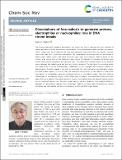Files in this item
Dissociations of free radicals to generate protons, electrophiles or nucleophiles : role in DNA strand breaks
Item metadata
| dc.contributor.author | Walton, John C. | |
| dc.date.accessioned | 2021-05-31T15:30:10Z | |
| dc.date.available | 2021-05-31T15:30:10Z | |
| dc.date.issued | 2021-07-07 | |
| dc.identifier | 274438693 | |
| dc.identifier | aedbaf2a-b673-413c-bd71-bdfb58be0311 | |
| dc.identifier | 000652636200001 | |
| dc.identifier | 85109210881 | |
| dc.identifier.citation | Walton , J C 2021 , ' Dissociations of free radicals to generate protons, electrophiles or nucleophiles : role in DNA strand breaks ' , Chemical Society Reviews , vol. 50 , no. 13 , pp. 7496-7512 . https://doi.org/10.1039/d1cs00193k | en |
| dc.identifier.issn | 0306-0012 | |
| dc.identifier.uri | https://hdl.handle.net/10023/23287 | |
| dc.description | Thanks to the University of St. Andrews and the EaStCHEM Research Computing Facility for financial and computational support. | en |
| dc.description.abstract | The concept behind the research described in this article was that of marrying the 'soft' methods of radical generation with the effectiveness and flexibility of nucleophile/electrophile synthetic procedures. Classic studies with pulse radiolysis and laser flash photolysis had shown that free radicals could be more acidic than their closed shell counterparts. QM computations harmonised with this and helped to define which radical centres and which structural types were most effective. Radicals based on the sulfonic acid moiety and on the Meldrum's acid moiety (2,2-dimethyl-1,3-dioxane-4,6-dione) were found to be extreme examples in the superacid class. The ethyne unit could be used as a very effective spacer between the radical centre and the site of proton donation. The key factor in promoting acidity was understood to be the thermodynamic stabilisation of the conjugate anion-radicals released on deprotonation. Solvation played a key part in promoting this and theoretical microhydration studies provided notable support. A corollary was that heterolytic dissociations of free radicals to yield either electrophiles or nucleophiles were also enhanced relative to non-radical models. The most effective radical types for spontaneous releases of both these types of reagents were identified. Ethyne units were again effective as spacers. The enhancement of release of phosphate anions by adjacent radical centres was an important special case. Reactive oxygen species and also diradicals from endiyne antibiotics generate C4 '-deoxyribose radicals from nucleotides. Radicals of these types spontaneously release phosphate and triphosphate and this is a contributor to DNA and RNA strand breaks. | |
| dc.format.extent | 17 | |
| dc.format.extent | 5910585 | |
| dc.language.iso | eng | |
| dc.relation.ispartof | Chemical Society Reviews | en |
| dc.subject | QD Chemistry | en |
| dc.subject | T-NDAS | en |
| dc.subject.lcc | QD | en |
| dc.title | Dissociations of free radicals to generate protons, electrophiles or nucleophiles : role in DNA strand breaks | en |
| dc.type | Journal item | en |
| dc.contributor.institution | University of St Andrews. School of Chemistry | en |
| dc.contributor.institution | University of St Andrews. EaSTCHEM | en |
| dc.identifier.doi | 10.1039/d1cs00193k | |
| dc.description.status | Peer reviewed | en |
This item appears in the following Collection(s)
Items in the St Andrews Research Repository are protected by copyright, with all rights reserved, unless otherwise indicated.

